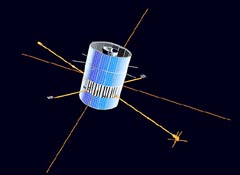
The Interplanetary Monitoring Platform (IMP) 8 spacecraft has radioed solar-wind conditions to Earth since 1973. The drum-shaped craft weighs 371 kilograms.
Courtesy NASA/Goddard Space Flight Center.
Bowing to pressure from NASA Headquarters to cut costs,
a space-science review panel has recommended that the agency cease communications
with an ancient, virtually unknown spacecraft. IMP 8, the last of NASA's
Interplanetary
Monitoring Platforms, rocketed into space on October 25, 1973, and
has been reliably studying the solar wind ever since. Only Pioneer 6
(launched in 1965) and Pioneer 10 (1972) have survived longer in space.
IMP 8 is so old that its telemetry link utilizes the VHF
radio band, long ago abandoned for routine spacecraft use. It has no
tape recorder; data are beamed to the ground continuously at 6,000 bits
per second. "We've got graduate students coming in to work with a spacecraft
launched before they were born," notes Karolen Paularena, an MIT space
physicist who routinely analyzes IMP
8 measurements. The craft's unusual orbit, roughly circular but
nearly halfway to the Moon, allowed instruments on board to monitor
electromagnetic conditions both inside and outside Earth's magnetosphere.
Scientific interest in IMP 8's data soared during the 1990s, when there
was a hiatus in spacecraft covering solar-wind activity, and at one
point a receiving station for the mission was erected at the South Pole.
But the launch of more recent spacecraft, especially the
Advanced Composition
Explorer in 1997, diminished IMP 8's value as a space sentinel.
Moreover, the failure of its magnetometer last year made the solar-wind
data less useful and probably sealed the spacecraft's fate. According
to Joseph H. King (NASA/Goddard Space Flight Center), the mission's
project scientist, seven of IMP 8's 11 experiments are functioning.
King adds that the spacecraft could still serve as a cosmic-ray monitor;
its observations complement those being made near the outer edge of
the heliosphere by Voyagers 1 and 2, which currently are 12.4 and 9.8
trillion kilometers, respectively, from the Sun. But the NASA review
board felt that this ancillary role did not justify the $1½ million
spent annually on the IMP 8 mission. Flight controllers sent their last
commands to the spacecraft last Friday, and data collection has ceased.
 0
0
Comments
You must be logged in to post a comment.